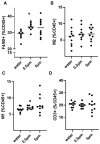Obesogenic polystyrene microplastic exposures disrupt the gut-liver-adipose axis
- PMID: 38291899
- PMCID: PMC10964747
- DOI: 10.1093/toxsci/kfae013
Obesogenic polystyrene microplastic exposures disrupt the gut-liver-adipose axis
Abstract
Microplastics (MP) derived from the weathering of polymers, or synthesized in this size range, have become widespread environmental contaminants and have found their way into water supplies and the food chain. Despite this awareness, little is known about the health consequences of MP ingestion. We have previously shown that the consumption of polystyrene (PS) beads was associated with intestinal dysbiosis and diabetes and obesity in mice. To further evaluate the systemic metabolic effects of PS on the gut-liver-adipose tissue axis, we supplied C57BL/6J mice with normal water or that containing 2 sizes of PS beads (0.5 and 5 µm) at a concentration of 1 µg/ml. After 13 weeks, we evaluated indices of metabolism and liver function. As observed previously, mice drinking the PS-containing water had a potentiated weight gain and adipose expansion. Here we found that this was associated with an increased abundance of adipose F4/80+ macrophages. These exposures did not cause nonalcoholic fatty liver disease but were associated with decreased liver:body weight ratios and an enrichment in hepatic farnesoid X receptor and liver X receptor signaling. PS also increased hepatic cholesterol and altered both hepatic and cecal bile acids. Mice consuming PS beads and treated with the berry anthocyanin, delphinidin, demonstrated an attenuated weight gain compared with those mice receiving a control intervention and also exhibited a downregulation of cyclic adenosine monophosphate (cAMP) and peroxisome proliferator-activated receptor (PPAR) signaling pathways. This study highlights the obesogenic role of PS in perturbing the gut-liver-adipose axis and altering nuclear receptor signaling and intermediary metabolism. Dietary interventions may limit the adverse metabolic effects of PS consumption.
Keywords: delphinidin; inflammation; metabolism disrupting chemical; microplastics; obesity; polystyrene.
© The Author(s) 2024. Published by Oxford University Press on behalf of the Society of Toxicology. All rights reserved. For permissions, please e-mail: journals.permissions@oup.com.
Figures







References
-
- Bligh E. G., Dyer W. J. (1959). A rapid method of total lipid extraction and purification. Can. J. Biochem. Physiol. 37, 911–917. - PubMed
-
- Brown D. M., Wilson M. R., MacNee W., Stone V., Donaldson K. (2001). Size-dependent proinflammatory effects of ultrafine polystyrene particles: A role for surface area and oxidative stress in the enhanced activity of ultrafines. Toxicol. Appl. Pharmacol. 175, 191–199. - PubMed
-
- Chavez-Talavera O., Tailleux A., Lefebvre P., Staels B. (2017). Bile acid control of metabolism and inflammation in obesity, type 2 diabetes, dyslipidemia, and nonalcoholic fatty liver disease. Gastroenterology 152, 1679–1694.e1673. - PubMed
-
- Chen H., Deng Y., Wang Q., Chen W., Liu Z., Tan H., Chen D. (2023). Large polystyrene microplastics results in hepatic lipotoxicity in mice. Environ. Pollut. 333, 122015. - PubMed
MeSH terms
Substances
Grants and funding
LinkOut - more resources
Full Text Sources
Medical
Research Materials

